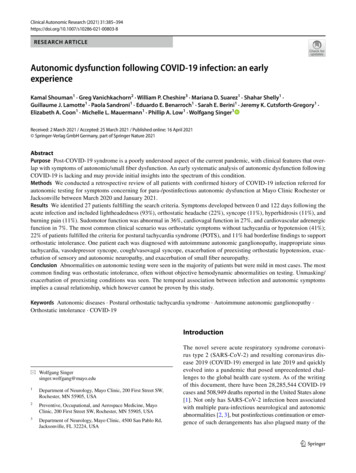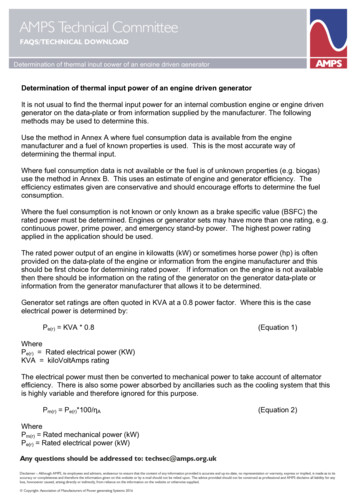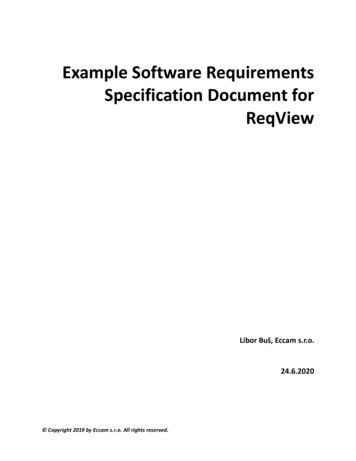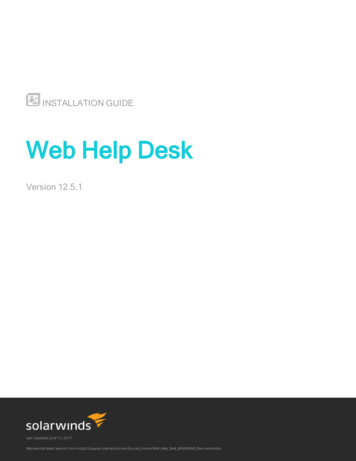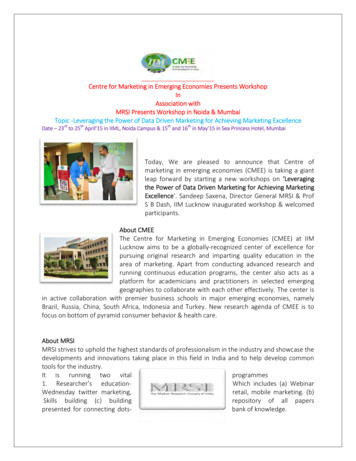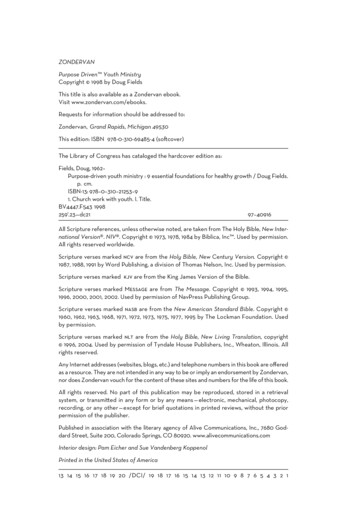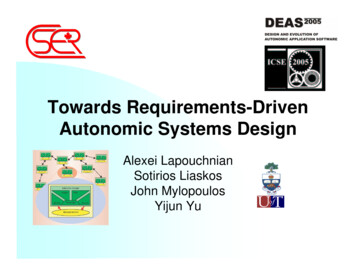
Transcription
Towards Requirements-DrivenAutonomic Systems DesignAlexei LapouchnianSotirios LiaskosJohn MylopoulosYijun YuMay 1-2, 2005
Agenda1.2.3.4.Autonomic computingGoal-oriented requirements engineeringHigh-variability designsTowards autonomic computing systems1. From goals to autonomic systems2. A hierarchical autonomic architecture3. Goal model-based autonomic behaviors5. ConclusionMay 1-2, 2005
1. Autonomic computingRequirements for AC systems Why autonomic computing in softwareengineering?– Moore’s law: hardware speed doubles every 18months– Lehman’s evolution law: software complexity isincreasing– Moore’s law versus Lehman’s law increasing software maintenance cost comparing tothe hardware costMay 1-2, 2005J. Kephartand D.M. Chess. “The vision of autonomic computing”.IEEE Computer Journal. 36(1):41-50. 2003.
Requirements of AC systemsThree basic ways to build such systems Designed to support all possible behaviors (our proposal) Delegating tasks to external agents (agent-oriented) To let evolution decides the better fits (evolutionary)To model all possible behaviors, we need to analyze therequirements of the AC system to be builtAn autonomic system requires: Adaptive: evolves like biology systems Intelligent: reasons like expert systems Self-awareness: senses the environment and selfwhat’s going on, what’s wrong, what’s better, what to change Self-conduct: plans without interventionwhat to do, how to change, May 1-2, 2005
2. Goal-oriented RE Before designing a system, analyze the goals(intentions) of stakeholders– divide and conquer: ask Why and How to establish solutions tothe problem– The solutions are result of AND/OR decomposition of theproblem Functional requirements are hard goals Non-functional requirements (NFR) are soft goalsNFRs are used to model quality attributes associatedwith metrics The result of GORE process is a goal model:the causal dependencies among requirementsA. van Lamsweerde. “From systems goals to software architectures”.FSE. 2004.May 1-2,L. 2005Chung, B.A. Nixon, E. Yu, J. Mylopoulos. Non-functional requirementsin software engineering. Kluwer Academic Press. 1999.
Meeting scheduler exampleMay 1-2, 2005
3. Variability: more than one waysto attain a goal A key difference between autonomic systems design andtraditional design: can the system adapt its behavior tothe environmental changes? Alternative ways to solve a problem are captured by theOR goal decompositions Alternatives in the goal model captures the variability inthe problem domain– Variability in problem domain must be reflected in the solutiondomain as alternative configurations, behaviors and structures– The selection criteria for THE solution can be guided bysoftgoals in the goal modelMay 1-2, 2005
Toward high-variability designs Variability in problem domain must be reflected in thesolution domain as alternative configurations,behaviors, structures, concerns, etc.1. Configure variability: feature models in the productline family software2. Behavioral variability: transitional systems typicallystatecharts3. Structural variability: components compositionspatterns in software architectures4. Concerns variability: aspect-oriented compositions5. and so on so forth May 1-2, 2005
Configuration variabilityB. Hui et al. “Requirements analysis for customizable software: goalsskills-preferences farmework”, RE’03.May 1-2,2005S.Liaskoset al. “Configuring common personal software: arequirements-driven approach”. To appear, RE’05.
you may not want to configurein more detailsMay 1-2, 2005
3.1 Converting into feature model!!"May 1-2, 2005"##
3.2 Converting into statechartsMay 1-2, 2005
3.3 Converting into ADL % &'May 1-2, 2005'
Light-weight enrichments Goal models in the AND/OR graph formneed to be enriched with design-specificinformation to transform into a design Keep it simple stupid: such enrichmentsare light-weight: minimal information toderive the design Keeping the traceability among thevariabilities is crucial to the design of ACsystemsMay 1-2, 2005
Enriching the goal models1. Feature models?– Mandatory or Options:System/Non-System boundary– Inclusive or Alternatives: OR/XOR2. Statecharts?If one knows data dependencies among leaf goals,control is either sequential (;) or parallel ( ).3. Software architecture?Data bindings for inputs and outputs (corresponds togoal topics)May 1-2, 2005
4. Towards AC systems Goal models high-variability design patterns AC systems An autonomicmanager ePlanExecuteMay 1-2, 2005
4.1 Goal models as the coreknowledge Autonomic elements are full-fledged intelligent agents;Goal models represent the requirements of agents Goal models help autonomic elements:– Monitor: goals-qualities-metrics (GQM) framework– Analyze: NFR and GSP frameworks -- ranking alternativesthrough softgoals (quality criteria)– Plan: Designing all alternatives and switching among them– Execute: high-variability design translations from enriched goalmodels Thus, properly enriched goal models are the coreknowledge for autonomic elementMay 1-2, 2005
4.2 HierarchicalAutonomic ArchitectureMay 1-2, 2005
Advantages of the HAA Reduces complexity of AC systems– Propagating high-level concerns to low-level concerns as guidingpolicies self-configuring– Propagating low-level metrics to high-level attention only whennecessary (localize the changes) self-managing– Monitoring costs of alternatives allows fast switching amongthem to reduce cost self-tuning– Monitoring the satisfaction of alternatives allows fast detectingfailures to invoke corrective tasks (modeled as delta-alternatives) self-healing Supporting mechanisms:Top-down and bottom-up qualitative and quantitativegoal reasoning algorithmsMay 1-2, 2005
4.3 Goal-model-basedautonomic behaviorsWhat do self-* behaviors mean for us in theMAPE feedback loops Self-configuration and reconfigurationChoosing the better configurations with respectto historical statistical data Self-optimizing (self-tuning)Monitoring NFR quality metrics with respect tothe analytical data Self-repairing (self-healing)Monitoring FR with respect to the analytical dataMay 1-2, 2005
5. Conclusion and future work Stakeholder requirements goals are the core knowledge ofautonomic elements in order to make AC applications adapt for thebetter in users’ perspectives Autonomic systems cost less at run-time with high-variability designs A hierarchical autonomic architecture is proposed to reduces thedesign-time complexity of AC systems Different autonomic behaviors are interpreted as differentapplications of goal models: goal monitoring, goal reasoning andgoal-to-design translationsFuture work: Implement the MAPE feedback loop with goal models Apply the goal-model based autonomic elements to AC softwaresystemsMay 1-2, 2005
QuestionsMay 1-2, 2005
Backup slides References Enrichments Translating patternsMay 1-2, 2005
References (1) Autonomic Computing systems– goal-oriented requirements engineering–– –Ladan Tahvildari, Kostas Kontogiannis, John Mylopoulos: “Quality-driven software reengineering”. Journal of Systems and Software 66(3): 225-239 (2003)quality-based software reuse– Y.Yu et al. “Software refactoring guided by multiple soft-goals”, REFACE@WCRE’03.quality-driven software reengineering– B. Hui et al. “Requirements analysis for customizable software: goals-skills-preferencesfarmework”, RE’03.S.Liaskos et al. “Configuring common personal software: a requirements-driven approach”.To appear, RE’05.goal-oriented software tuning– A. van Lamsweerde. “From systems goals to software architectures”. FSE. 2004.L. Chung, B.A. Nixon, E. Yu, J. Mylopoulos. Non-functional requirements in softwareengineering. Kluwer Academic Press. 1999.goal-oriented software configuration– J. Kephart and D.M. Chess. “The vision of autonomic computing”. IEEE Computer Journal.36(1):41-50. 2003.J.C.Leite, et al. “Quality-based software reuse”, CAiSE’05.reverse engineering goal models–Y.Yu, et al. “From goals to aspects: discovering aspects from requirements goal models”.RE’04.– Y.Yu et al. “Reverse engineering goals from source code”, to appear, RE’05.– S.Liaskos et al. “Configuring common personal software: a requirements-driven approach”.May 1-2,To2005appear, RE’05.
References (2)On High-variability software design Feature model and product-line family:– K.C. Kang et al. “Feature-oriented domain analysis (FODA) feasibility study”,SEI. 1990.– K. Czarnecki et al. Generative Programming: Methods, Tools, and Applications.Addison-Wesley, 2000.– D. Batory et al. “Scaling Stepwise Refinements”. ICSE 2003.Statecharts– D. Harel. “The STATEMATE Semantics of Statecharts”. TOSEM 5(4):293—333. Software architectures and ADL– L. Bass et al. Software Architecture in Practice, 2nd Ed. Addison-Wesley, 1998. Aspect-oriented programming– G. Kiczales. “Aspect-oriented programming”. EOOP. 1997.– C. Zhang et al. “Just-in-time middleware configuration using aspects”. AOSD’05.May 1-2, 2005
3.1b For configuring variability( )May 1-2, 2005( )
3.2b For behavioral variability( )( )May 1-2, 2005
3.3b For structural variability # #! *"#%')# &#' ## #May 1-2, 2005
3.1c From goal to feature,,,,/-.01May 1-2, 2005( )-.0 10,,--.-1.0-,-1.,-.
3.2c From goal to state1. Defining states2. Treating dependenciesMay 1-2, 20053. Transforming hierarchies4. Simplifying leaf statecharts
3.3c From goal to interfacesMay 1-2, 2005
quality-driven software reengineering - Ladan Tahvildari, Kostas Kontogiannis, John Mylopoulos: "Quality-driven software re-engineering". Journal of Systems and Software 66(3): 225-239 (2003) quality-based software reuse - J.C.Leite, et al. "Quality-based software reuse", CAiSE'05. reverse engineering goal models
